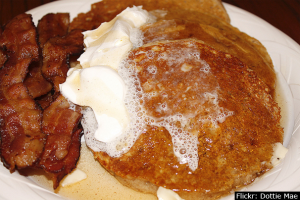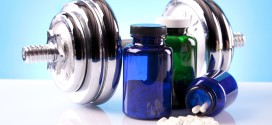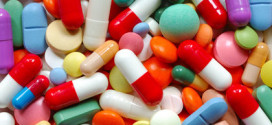The competition season is over and the winter is now upon us, which can only mean one thing for bodybuilders; it’s time to bulk. But faced with the task to build as much muscle as humanly possible which is the better option; to consume 5,000 calories a day and ‘dirty bulk’ or to keep an eye on your calorie surplus, continue with the cardio and try a ‘clean bulk’?
We’ve teamed up with the guys at The Protein Works to explain why a clean bulk may be a better option.
Deficiency Of Nutrients
 It’s commonly known that to increase muscle mass you need to create a ‘calorie surplus’, this is just simply where you need to consume more calories than you burn. However a common mistake amongst bodybuilders is to immediately reach for the pizza, burgers, soft drinks and ice cream thinking that the extra calories will also add extra quality muscle. The only problem is whilst your body meets its daily calorie needs, it will be lacking in certain other vitamins and minerals that are needed for muscle growth. For instance ice cream and soft drinks aren’t exactly known for being a great source of minerals and what’s worse is that a lot of them contain phosphates that have been shown to deplete the body’s iron stores. Iron is obviously hugely important to bodybuilders since it’s vital for the transportation of oxygen by haemoglobin and muscles using oxygen by myoglobin. Having less iron in the body means less oxygen can be delivered to the working muscles. Talking more generally, junk food such as doughnuts or pastries lack various muscle building micronutrients such as zinc which serves as a cofactor in more than 100 enzyme processes within the body, the most important being to help build DNA, protein, insulin and testosterone production. Obviously insulin is needed by the body to shuttle key nutrients such as amino acids to the muscles and testosterone is a hugely important anabolic hormone and without sufficient zinc in the diet both are affected. Whilst there are too many nutrients to name specifically, it’s important to note that high calorie diets can lead to nutrient deficiency or a new form of malnutrition as described by scientists Orit Kaidar-Person et al (2008) which will ultimately leave your muscles underfed and will stunt their growth. Therefore concerning nutrients, it’s much wiser to attempt a clean bulk and ensure you create a calorie surplus through more nutrient dense foods since this will ensure your body also receives the often overlooked micronutrients it needs for muscular hypertrophy.
It’s commonly known that to increase muscle mass you need to create a ‘calorie surplus’, this is just simply where you need to consume more calories than you burn. However a common mistake amongst bodybuilders is to immediately reach for the pizza, burgers, soft drinks and ice cream thinking that the extra calories will also add extra quality muscle. The only problem is whilst your body meets its daily calorie needs, it will be lacking in certain other vitamins and minerals that are needed for muscle growth. For instance ice cream and soft drinks aren’t exactly known for being a great source of minerals and what’s worse is that a lot of them contain phosphates that have been shown to deplete the body’s iron stores. Iron is obviously hugely important to bodybuilders since it’s vital for the transportation of oxygen by haemoglobin and muscles using oxygen by myoglobin. Having less iron in the body means less oxygen can be delivered to the working muscles. Talking more generally, junk food such as doughnuts or pastries lack various muscle building micronutrients such as zinc which serves as a cofactor in more than 100 enzyme processes within the body, the most important being to help build DNA, protein, insulin and testosterone production. Obviously insulin is needed by the body to shuttle key nutrients such as amino acids to the muscles and testosterone is a hugely important anabolic hormone and without sufficient zinc in the diet both are affected. Whilst there are too many nutrients to name specifically, it’s important to note that high calorie diets can lead to nutrient deficiency or a new form of malnutrition as described by scientists Orit Kaidar-Person et al (2008) which will ultimately leave your muscles underfed and will stunt their growth. Therefore concerning nutrients, it’s much wiser to attempt a clean bulk and ensure you create a calorie surplus through more nutrient dense foods since this will ensure your body also receives the often overlooked micronutrients it needs for muscular hypertrophy.
Delivery Of Nutrients
The next issue regarding a dirty bulk is related to your insulin sensitivity. Firstly insulin is a hormone responsible for shuttling nutrients to the muscles and insulin sensitivity relates to how much of the hormone insulin your body needs to shuttle these nutrients to muscles. Put simply ‘good insulin sensitivity’ means your body only needs a small amount to transport nutrients to the muscles whereas ‘bad insulin sensitivity’ means your body isn’t very good at shuttling nutrients to the muscles and requires a lot of insulin, plus even worse than that you’re also on track to diabetes. Now whilst insulin sensitivity varies from person to person research shows that a dirty bulk won’t help matters. Specifically this relates to fast food and its content of trans fatty acids (trans fats) which is an artificially made fat that’s used when making pastries, cookies, doughnuts and French fries.  It’s responsible for that ‘melt in your mouth’ type feeling you get from a really nice doughnut or cookie and although it tastes amazing, researchers Mark. A Pereira et al (2005) state it negatively affects insulin sensitivity. This means although certain French fries taste amazing and they will help you create a calorie surplus, they will detrimentally affect insulin sensitivity and therefore how effectively nutrients are transported to the muscles. This exact principle also applies with foods that are high in fructose such as certain pre-packaged cereals, junk food deserts, potato chips, soft drinks and shockingly certain snack bars that are advertised as healthy since researchers Heather Basciano et al (2005) found that diets contain a high amount of fructose again negatively affected insulin sensitivity. So again whilst washing your ‘dirty bulking’ meal down with a litre of orange fizzy drinks may help you get the calories in, your muscles won’t thank you for the reduced insulin sensitivity (Bray G.A, 2010).
It’s responsible for that ‘melt in your mouth’ type feeling you get from a really nice doughnut or cookie and although it tastes amazing, researchers Mark. A Pereira et al (2005) state it negatively affects insulin sensitivity. This means although certain French fries taste amazing and they will help you create a calorie surplus, they will detrimentally affect insulin sensitivity and therefore how effectively nutrients are transported to the muscles. This exact principle also applies with foods that are high in fructose such as certain pre-packaged cereals, junk food deserts, potato chips, soft drinks and shockingly certain snack bars that are advertised as healthy since researchers Heather Basciano et al (2005) found that diets contain a high amount of fructose again negatively affected insulin sensitivity. So again whilst washing your ‘dirty bulking’ meal down with a litre of orange fizzy drinks may help you get the calories in, your muscles won’t thank you for the reduced insulin sensitivity (Bray G.A, 2010).
Harder To Cut
Very closely linked to insulin sensitivity is how effectively you will be able to cut once you’ve bulked. This is because whilst insulin helps to transport nutrients to the muscles, it’s also the most lipolytic (fat storing) hormone in the body, shuttling fatty acids and glucose to fat cells to be stored as body fat. For this reason no bodybuilder will want bad insulin sensitivity when cutting since this means their body will release more insulin which in turn reduces lipolysis (the burning of fat) and increases lipogensis (the storing of body fat.) So the final point to consider is that whilst dirty bulking may produce short term gains and also look very impressive as you stand on the scales and gain 5 lbs. a week, it may not be very good in the long term and actually be counterproductive when you’re trying to cut for a competition or the summer.
References:
Orit Kaidar-Person, Benjamin Person, Samuel Szomstein and Raul J. Rosenthal (2008) ‘Nutritional Deficiencies in Morbidly Obese Patients: A New Form of Malnutrition?’ Volume 18, Number 7 (2008), 870-876
Mark J. Fedele, Jazmir M. Hernandez, Charles H. Lang, Thomas C. Vary, Scot R. Kimball, Leonard S. Jefferson, and Peter A. Farrell. (2000). ‘Severe diabetes prohibits elevations in muscle protein synthesis after acute resistance exercise in rats’. Journal Of Applied Physiology, 88(1), 102-108.
Mark A Pereira, Alex I Kartashov, Cara B Ebbeling, Linda Van Horn, Prof Martha L Slattery, David R Jacobs and David S Ludwig (2005) ‘Fast-food habits, weight gain, and insulin resistance (the CARDIA study): 15-year prospective analysis’ The Lancet, Volume 365, Issue 9453, Pages 36 – 42, 1 January 2005
Heather Basciano, Lisa Federico and Khosrow Adeli(2005) ‘Fructose, insulin resistance, and metabolic dyslipidemia’ Nutrition & Metabolism 2005, 2:5 doi:10.1186/1743-7075-2-5
Bray G.A (2010) ‘Soft drink consumption and obesity: it is all about fructose’ Current Opinion In Lipidology, 2010 Feb;21 (1):51-7..
 Supplement Judge Unbiased Supplement Reviews – Do they really work??
Supplement Judge Unbiased Supplement Reviews – Do they really work??




